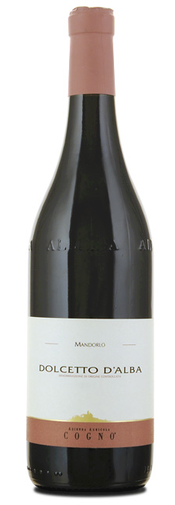|
|
 |

Elvio Cogno, Dolcetto d’Alba (Piedmont, Italy) Vigna del Mandorlo 2011 (Vias Imports, about $16): I drink Dolcetto wines frequently, but I generally don’t think about them a lot: Dolcetto is simply one of my go-to red wines. In the Piedmont region of Italy, Dolcetto plays much the same role around many a dinner table: It is the starter red wine, the wine  to sip with pre-dinner nibbles of dried salami or with antipasti at the table, leaving room for the more important red wines with the rest of the meal. Granted, the Dolcetto grape has some tough local competition from Barbera and especially Nebbiolo, the grape that makes Barolo and Barbaresco. Nonetheless, some Dolcetto wines have begun to attract a spotlight, because under the right circumstances they can be impressive. to sip with pre-dinner nibbles of dried salami or with antipasti at the table, leaving room for the more important red wines with the rest of the meal. Granted, the Dolcetto grape has some tough local competition from Barbera and especially Nebbiolo, the grape that makes Barolo and Barbaresco. Nonetheless, some Dolcetto wines have begun to attract a spotlight, because under the right circumstances they can be impressive.
The right circumstances include a gifted terroir such as the hillsides around the town of Dogliani, south of the town of Barolo, or a gifted producer who has a particular feeling for the Dolcetto grape. The Cogno family is such a producer. Not only has the family been making wine for four generations in the Langhe area around the town of Alba, but also Elvio Cogno has a personal history with fine Dolcetto. Before establishing his own family winery in the early 1990s, Cogno was a partner and winemaker at Cogno-Marcarini, and one of his prize wines was Dolcetto d’Alba Boschi di Berri, an intense Dolcetto made from very old, ungrafted vines. (Podere Marcarini, as it is now called, still produces Boschi di Berri Dolcetto.)
Vigna del Mandorlo, the vineyard that gives its name to this Cogno Dolcetto, is a six-acre site at more than 1200 feet in altitude, with vines that are upwards of 70 years old. It is a special site for Dolcetto, nurtured by a family that has always taken Dolcetto seriously. Winemaker Valter Fissore, who is Elvio’s son-in-law, produces the wine with no oak aging.
The wine is deep ruby, almost purple in color, with a concentrated aroma of red berries and dried black cherries. In your mouth the wine is dry and nearly full-bodied, with marked tannin that’s offset by very ripe fruit. Dolcetto often has aromas or flavors of black pepper and here they emerge, subtly, in the mouth, as an accent to the fruit flavors of blackberries and wild berries. True to Dolcetto’s typical style, the wine is spicy, edgy and energetic despite its ripeness. One characteristic of this wine that sets it apart from most Dolcetto wines, however, is its texture; typical Dolcetto is quite dry-textured, but this wine is actually smooth. Its quality also comes through in the length of the wine’s taste across your mouth and into its finish.
Dolcetto is the earliest ripening of Piedmont’s red grapes, and in the warm and early 2011 growing season, some dehydration caused yields to drop for this variety. The concentration and intensity of this wine are consistent with reduced yields -- but thankfully the wine’s freshness and vibrancy defy the cooked-fruit stereotype of warm-vintage reds.
I enjoy drinking this wine without food, but I suspect my tastes are not typical in this regard. In fact, this wine shines with food. Try it with pasta in a sauce of broccolirabe and sausage, or a frittata of Swiss chard and Canadian bacon, or even an Asian-inspired pork stir-fry. This 2011 does give you some grainy sediment in the last glass you pour.
90 Points
|
 |
|